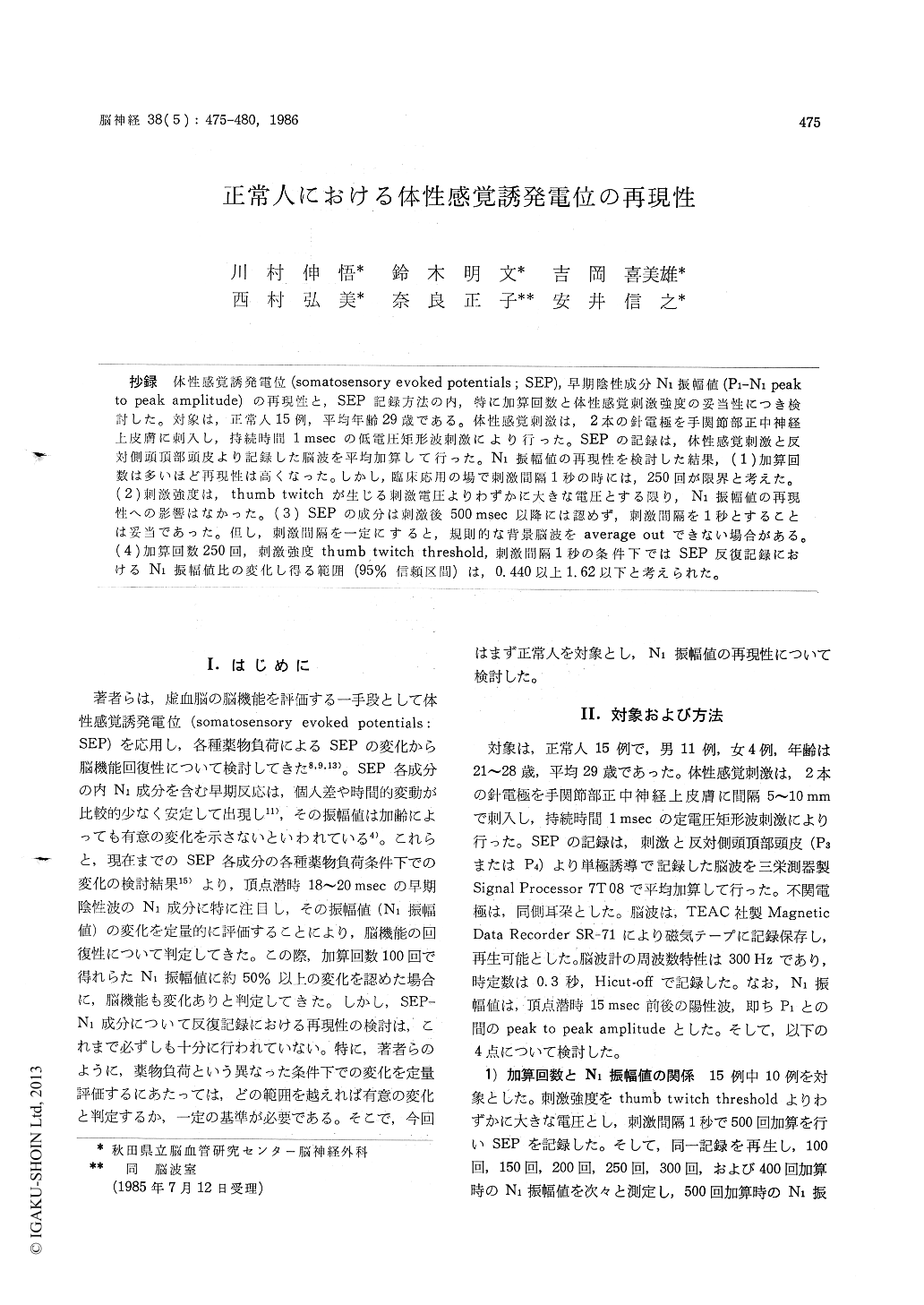5 0 0 0 OA 脳動脈瘤手術の工夫
- 著者
- 波出石 弘 鈴木 明文 師井 淳太
- 出版者
- 一般社団法人 日本脳卒中の外科学会
- 雑誌
- 脳卒中の外科 (ISSN:09145508)
- 巻号頁・発行日
- vol.34, no.5, pp.340-346, 2006 (Released:2008-08-08)
- 参考文献数
- 11
- 被引用文献数
- 9 8
In surgical procedures to dissect the sylvian fissure, the fissure is commonly unfolded by the attachment of all sylvian veins to the temporal lobe. During this procedure, cerebral edema and contusion in the frontal lobe are often caused by sacrificing bridging veins from the frontal lobe and excessive retraction on the frontal lobe. In this procedure, some sylvian veins must be kept on the side of the frontal lobe to preserve the bridging vein. In many cases, detachment of the sylvian vein from the surface of the temporal lobe is required. The sylvian vein can be detached from the temporal lobe using the space around the temporal artery right under the sylvian vein. For detachment of adhesions between the frontal and temporal lobes, a “paper knife technique” is available in which a surgical site is generated by cutting upwards from the subarachnoid space around M1. In a “denude technique,” a wide surgical field can be obtained with less retraction of the frontal lobe by detaching the arachnoid membrane from the sylvian vein and thus allowing venous extension. During dissection of the sylvian fissure, arteries and veins belonging to the temporal lobe spread while adhering to the frontal lobe. In this case, the site to dissect is the frontal-lobe side where the vessels are located, even if the sylvian fissure is widely unfolded. Conversely, when cerebral vessels belonging to the frontal lobe are attached to the temporal lobe, the site to dissect is on the temporal lobe side, where the vessels are located. Thus the concept of a “microvascular sylvian fissure” in which detailed vessel structures are captured at a microscopic level is important in terms of preventing damage to blood vessels, pia matter and brain tissue. It is crucial to obtain a large surgical field and confirm where blood vessels belong. To detach an aneurysm attached to arteries such as M2, A2 or perforating arteries and deep veins, without causing damage, using the tip of micro-forceps for microvascular anastomosis as a raspatory is useful. Other detailed technical ideas are introduced. These include: pulling the aneurysm into the surgical site by transposing the artery and aneurysm using brain spatulas, silk threads, and Aron alpha to confirm adjacent vascular structures such as perforating arteries; using a “double-clip technique” to confirm complete clipping with 2 clips; and deliberately shifting the bayonet clip to preserve perforating arteries.
- 著者
- 峰松 一夫 矢坂 正弘 米原 敏郎 西野 晶子 鈴木 明文 岡田 久 鴨打 正浩
- 出版者
- 一般社団法人 日本脳卒中学会
- 雑誌
- 脳卒中 (ISSN:09120726)
- 巻号頁・発行日
- vol.26, no.2, pp.331-339, 2004-06-25 (Released:2009-06-05)
- 参考文献数
- 14
- 被引用文献数
- 7 10
【目的】若年者脳血管障害の頻度や臨床的特徴を明らかにする.【方法】統一形式の調査票を用い,1998年と1999年の2年間に入院した発症7日以内の51歳以上の脳卒中症例の概略と,1995年から1999年までに入院した発症1カ月以内の50歳未満の脳卒中症例の詳細を全国18施設で後ろ向きに調査した.【結果】合計7,245症例のデータが集積された.発症1週間以内入院の全脳卒中に占める若年者脳卒中の割合(調査期間補正後)は,50歳以下で8.9%,45歳以下で4.2%,40歳以下で2.2%であった.背景因子を51歳以上(非若年群)と50歳以下(若年群)で比較すると,高血圧(62.7%vs.48.5%),糖尿病(21.7%vs.13.6%),高コレステロール血症(16.5%vs.13.1%)及び非弁膜性心房細動の占める割合(21.2%vs.4.7%)は非若年群の方が高く(各p<0.01),男性(58.9%vs.62.8%),喫煙者(19.3%vs.27.3%)と卵円孔開存例(0.7vs.1.2%)は若年群で多かった(各々p<0.01,p<0.01,p=0.08).TIAの頻度に差は無かったが,脳梗塞(62.6%vs.36.7%)は非若年群で,脳出血(20.8%vs.32.1%)とくも膜下出血(7.3%vs.26.1%)は若年群で高かった(各p<0.01).若年群の原因疾患として動脈解離,Willis動脈輪閉塞症,脳動静脈奇形,抗リン脂質抗体症候群などが目立ったが,凝固系の検査や塞栓源の検索は必ずしも十分ではなかった.外科的治療は37.5%で,退院時の抗血栓療法は31.9%で施行された.退院時転帰は26.0%で要介助,死亡率は8.8%であった.【結論】全脳卒中に占める若年者脳卒中の割合は低く,その背景因子は非若年者のそれと大きく異なる.若年者脳卒中への対策の確立のためには,全国規模のデータバンクを構築し,適切な診断方法や治療方法を明らかにする必要がある.
1 0 0 0 OA 脳卒中によるPure motor monoparesis
- 著者
- 佐藤 美佳 長田 乾 鈴木 明文
- 出版者
- 一般社団法人 日本脳卒中学会
- 雑誌
- 脳卒中 (ISSN:09120726)
- 巻号頁・発行日
- vol.27, no.3, pp.396-401, 2005-09-25 (Released:2009-06-05)
- 参考文献数
- 12
脳卒中によりPure motor monoparesis(PMM)を呈した症例について,急性期の頭部MRI拡散強調画像を用いて検討した.5年間の脳梗塞,脳出血連続症例3226例中,PMMは32例(約1%;上肢26例,下肢6例)で,31例は脳梗寒,1例のみ脳出血であった.上肢のPMMの責任病巣は,放線冠や半卵円中心や中心前回に,下肢のPMMは内包後脚―放線冠後部に多く認められた.9例で2つ以上の多発性の病巣を認めた.発症機序による検討では,動脈原性塞栓8例(25%),心原性塞栓7例(21.9%)と約半数が塞栓性機序であった.抗血小板,抗凝固療法を開始したが,約2.9年の観察期間において7例(21.9%)が脳梗塞を再発した.PMMは,小梗塞でも塞栓性機序が稀ではなく,再発のリスクも考え,的確な診断と治療が必要である.
1 0 0 0 OA 延髄梗塞の臨床的検討
- 著者
- 山崎 貴史 中瀬 泰然 小倉 直子 亀田 知明 前田 哲也 佐藤 雄一 高野 大樹 鈴木 明文 長田 乾
- 出版者
- 一般社団法人 日本脳卒中学会
- 雑誌
- 脳卒中 (ISSN:09120726)
- 巻号頁・発行日
- vol.29, no.4, pp.502-507, 2007-07-25 (Released:2009-02-06)
- 参考文献数
- 20
- 被引用文献数
- 3 2
急性期延髄梗塞連続114例を対象に臨床症状と画像所見との関連性を解析した. MRI所見は, 内側梗塞 (MMI) と外側梗塞 (LMI) に分類し, 発症年齢はMMI (68.3歳) がLMI (63.1歳) より有意に高齢であった. MMIはさらに錐体限局型と広範囲型に, LMIは背側型, 前腹側型, 後腹側型, 汎腹側型, 前外側型に分類した. MMIでは広範囲型が77.4%, LMIでは後腹側型が45.8%, 背側型が28.8%であった. MMIでは病巣分布にかかわらず顔を除く健側半身の感覚障害が49.1%, LMIの後腹側型で病側顔面と健側半身の感覚障害が55.6%にみられた. MMIは上部病変が66%, LMIは中部病変が66%であった. 上部病変では顔面麻痺, 中部病変で吃逆が高頻度に認められ, 入院時のMRIで偽陰性が有意に多かったことから, 急性発症の顔面麻痺や吃逆を伴う半身の感覚障害を呈するときには延髄梗塞が強く疑われる.
1 0 0 0 正常人における体性感覚誘発電位の再現性
- 著者
- 川村 伸悟 鈴木 明文 吉岡 喜美雄 西村 弘美 奈良 正子 安井 信之
- 出版者
- 医学書院
- 雑誌
- Brain and Nerve 脳と神経 (ISSN:00068969)
- 巻号頁・発行日
- vol.38, no.5, pp.475-480, 1986-05-01
抄録 体性感覚誘発電位(somatosensory evoked potentials:SEP),早期陰性成分N1振幅値(P1-N1 peakto peak amplitude)の再現性と,SEP記録方法の内,特に加算回数と体性感覚刺激強度の妥当性につき検討した。対象は,正常人15例,平均年齢29歳である。体性感覚刺激は,2本の針電極を手関節部正中神経上皮膚に刺入し,持続時閥1msecの低電圧矩形波刺激により行った。SEPの記録は,体性感覚刺激と反対側頭頂部頭皮より記録した脳波を平均加算して行った。N1振幅値の再現性を検討した結果,(1)加算回数は多いほど再現性は高くなった。しかし,臨床応用の場で刺激間隔1秒の時には,250回が限界と考えた。(2)刺激強度は,thumb twitchが生じる刺激電圧よりわずかに大きな電圧とする限り,N1振幅値の再現性への影響はなかった。(3) SEPの成分は刺激後500msec以降には認めず,刺激間隔を1秒とすることは妥当であった。但し,刺激間隔を一定にすると,規則的な背景脳波をaverage outできない場合がある。(4)加算回数250回,刺激強度thumb twitch threshold,刺激間隔1秒の条件下ではSEP反復記録におけるN1振幅値比の変化し得る範囲(95%信頼区間)は,0.440以上1.62以下と考えられた。
- 著者
- 峰松 一夫 矢坂 正弘 米原 敏郎 西野 晶子 鈴木 明文 岡田 久 鴨打 正浩
- 出版者
- The Japan Stroke Society
- 雑誌
- 脳卒中 (ISSN:09120726)
- 巻号頁・発行日
- vol.26, no.2, pp.331-339, 2004-06-25
- 被引用文献数
- 9 10
【目的】若年者脳血管障害の頻度や臨床的特徴を明らかにする.<BR>【方法】統一形式の調査票を用い,1998年と1999年の2年間に入院した発症7日以内の51歳以上の脳卒中症例の概略と,1995年から1999年までに入院した発症1カ月以内の50歳未満の脳卒中症例の詳細を全国18施設で後ろ向きに調査した.<BR>【結果】合計7,245症例のデータが集積された.発症1週間以内入院の全脳卒中に占める若年者脳卒中の割合(調査期間補正後)は,50歳以下で8.9%,45歳以下で4.2%,40歳以下で2.2%であった.背景因子を51歳以上(非若年群)と50歳以下(若年群)で比較すると,高血圧(62.7%vs.48.5%),糖尿病(21.7%vs.13.6%),高コレステロール血症(16.5%vs.13.1%)及び非弁膜性心房細動の占める割合(21.2%vs.4.7%)は非若年群の方が高く(各p<0.01),男性(58.9%vs.62.8%),喫煙者(19.3%vs.27.3%)と卵円孔開存例(0.7vs.1.2%)は若年群で多かった(各々p<0.01,p<0.01,p=0.08).TIAの頻度に差は無かったが,脳梗塞(62.6%vs.36.7%)は非若年群で,脳出血(20.8%vs.32.1%)とくも膜下出血(7.3%vs.26.1%)は若年群で高かった(各p<0.01).若年群の原因疾患として動脈解離,Willis動脈輪閉塞症,脳動静脈奇形,抗リン脂質抗体症候群などが目立ったが,凝固系の検査や塞栓源の検索は必ずしも十分ではなかった.外科的治療は37.5%で,退院時の抗血栓療法は31.9%で施行された.退院時転帰は26.0%で要介助,死亡率は8.8%であった.<BR>【結論】全脳卒中に占める若年者脳卒中の割合は低く,その背景因子は非若年者のそれと大きく異なる.若年者脳卒中への対策の確立のためには,全国規模のデータバンクを構築し,適切な診断方法や治療方法を明らかにする必要がある.
